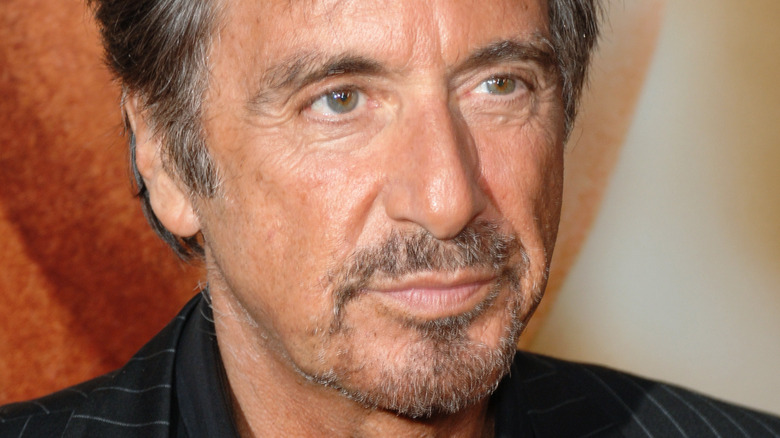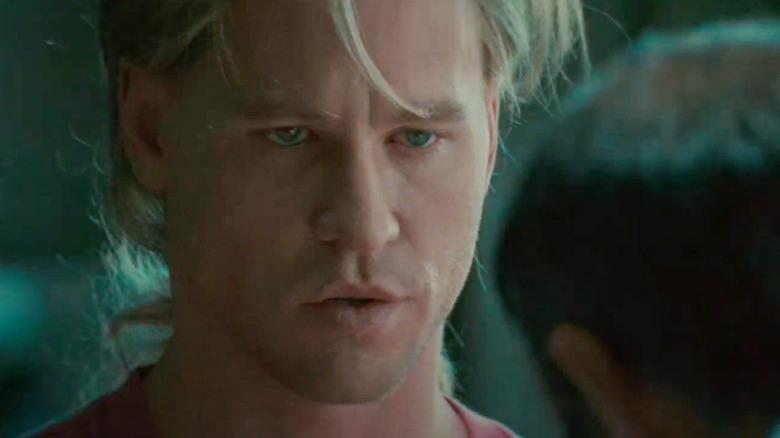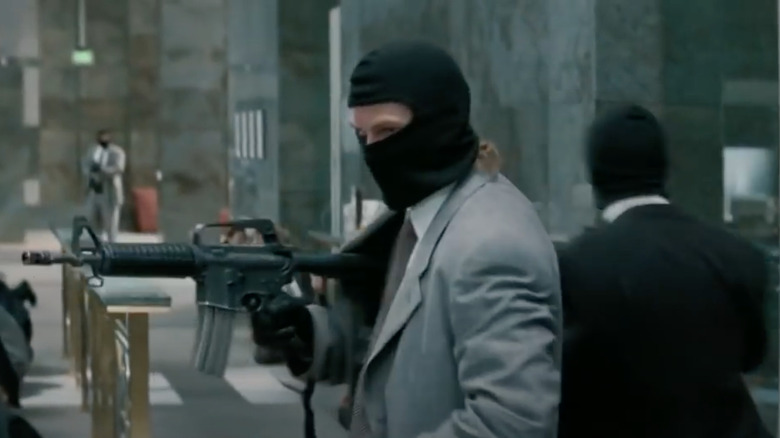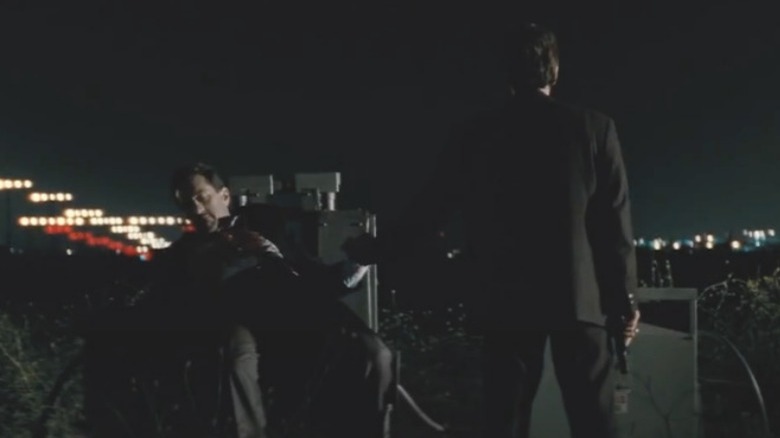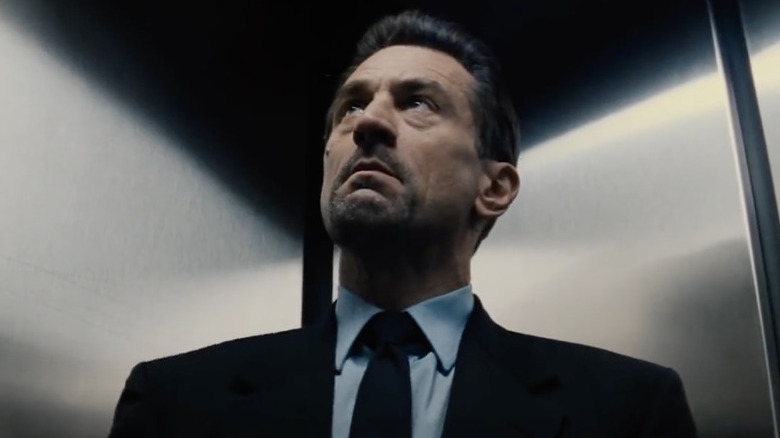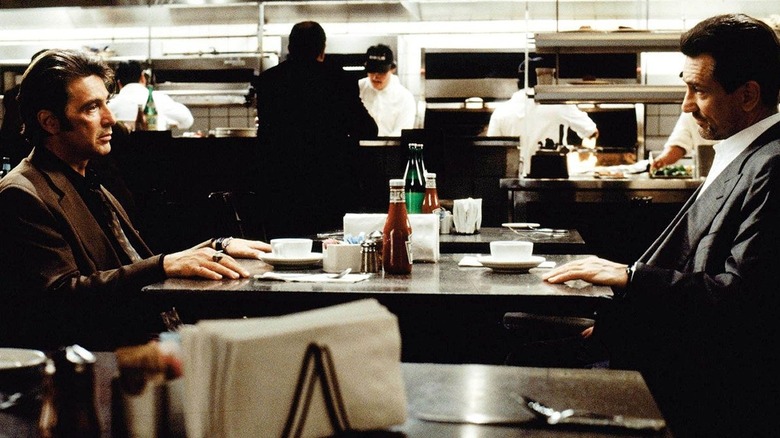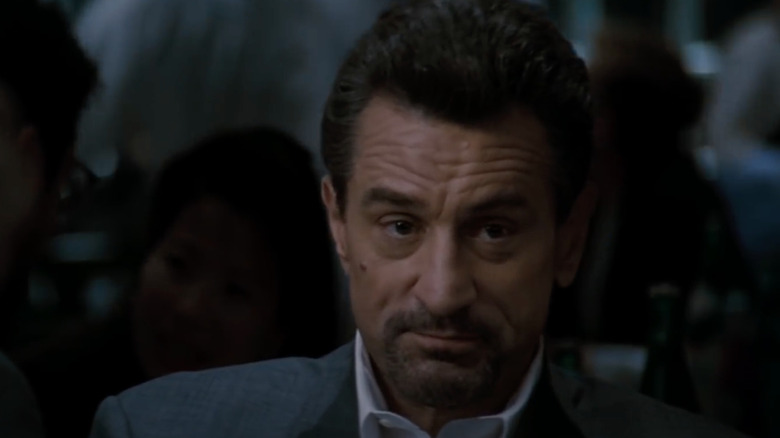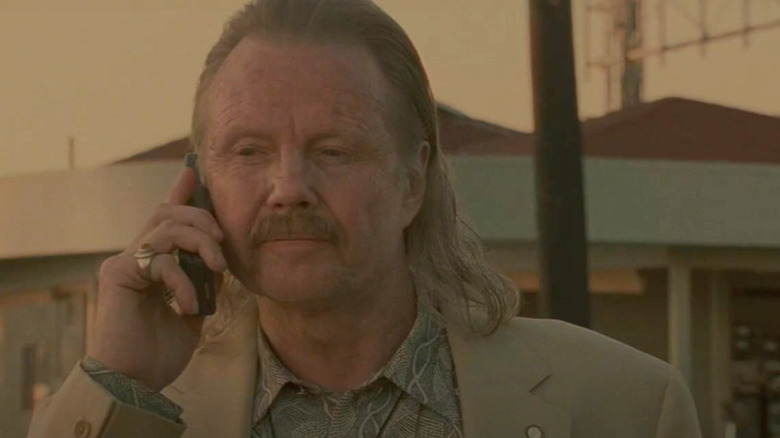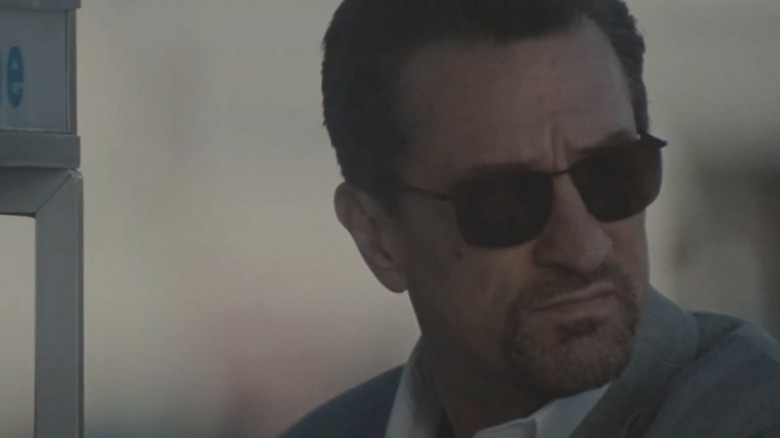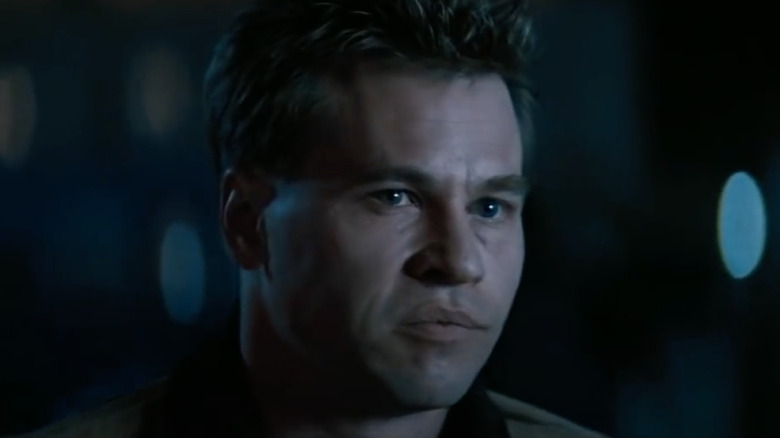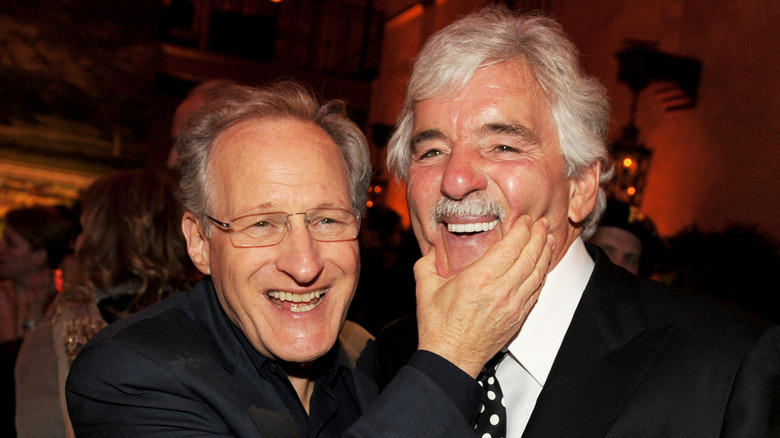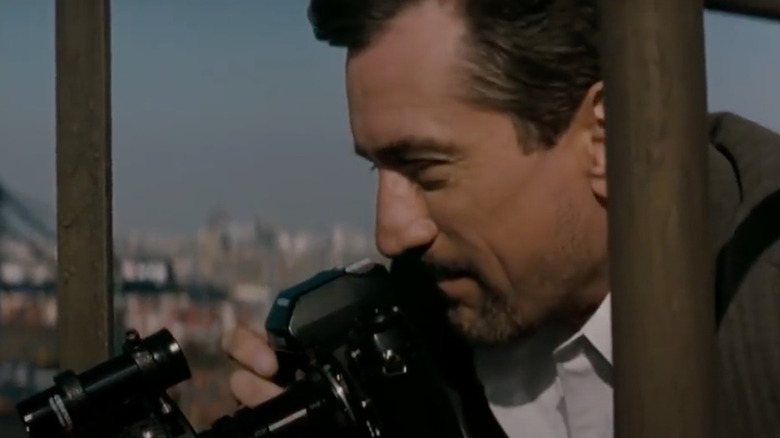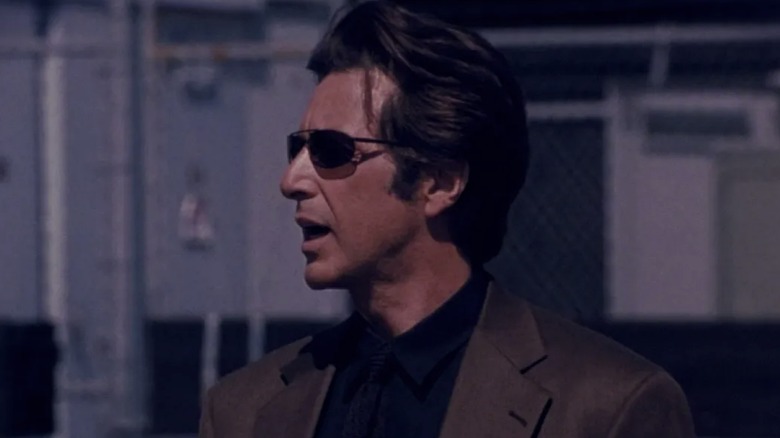Everything Heat Doesn't Tell You About The True Story
Michael Mann's "Heat" is one of the all-time great crime dramas, a classic cops-and-robbers thriller known for its stunning set pieces, fascinating characters, and knockout cast. Starring Robert De Niro, Al Pacino, Val Kilmer, Ashley Judd, Jon Voight, Tom Sizemore, Amy Brenneman and Natalie Portman, among others, "Heat" tells the story of Lieutenant Vincent Hanna (Pacino) and his pursuit of famed criminal mastermind Neil McCauley (De Niro). The film delves deep into the lives of its two lead characters, revealing they are essentially opposite sides of the same coin. These two like-minded fellows do what they do best, and it's only a matter of time before their paths cross in an epic showdown for the ages.
Sounds like pure cinema, right? Well, did you know that "Heat" is actually inspired by a true story? In fact, much of what you see in the film actually occurred in real life, including the famed diner meet-up between Hanna and McCauley (which also placed Hollywood giants and "The Godfather Part II" co-stars Pacino and De Niro on the same screen for the first time), and that famous LA shootout, albeit with some cinematic flourishes.
While the film sticks closely to the source material, we thought it'd be cool to do a rundown of the things "Heat" doesn't tell you about its true story. Don't let yourself get attached to anything in the article you are not willing to walk out on in 30 seconds flat if you feel the heat around the corner.
The real story took place in the 1960s
Perhaps the biggest difference in Michael Mann's "Heat" from the true story that inspired it is the time and setting it takes place in. Where the events of the film occur in Los Angeles circa 1995 and feature all the hallmarks of the era — large cellphones, mullets, young Val Kilmer — the true story actually took place in Chicago in the early 1960s.
The real Neil McCauley (yes, Mann used his real name) hit the streets in 1962 following a long stint in prison and immediately set out forming a crew for a new series of heists. Detective Chuck Adamson (the man who inspired the Vincent Hanna character) caught wind of McCauley's plans and tracked the hardened criminal for several years. According to the Chicago Tribune, McCauley's crew "was believed to have committed at least six robberies in the Chicago area" before their final confrontation with Adamson in 1964.
McCauley's crew didn't rob a bank
The turning point in "Heat" arrives about two hours into the picture, when McCauley's crew robs a bank in downtown Los Angeles. Poised, cool and collected, the trio of men head into the large facility — a fourth, Donald Breedan (Dennis Haysbert), waits outside in a getaway vehicle — armed with assault rifles and really cool sunglasses. After taking out the security crew, McCauley's men then make for the vault where they load duffel bags with enormous stacks of cash. It's an amazing sequence (one that inspired the infamous North Hollywood shootout) — except it's entirely fictional.
In reality, McCauley didn't rob a bank in downtown Los Angeles. Rather, he and his cohorts followed an armored truck to the National Tea Company grocery store in Chicago, where they held up the joint and fled with over $13,000 in cash. We probably don't even have to explain why a grocery store robbery isn't quite as exciting as a bank heist, at least thematically speaking. Seeing De Niro and company risk their lives for $12 million in cash is obviously a lot more exciting than seeing some hotheads do the same for the equivalent of $100,000 in today's dollars.
For those unaware, the National Tea Company was founded in 1899 and went on to become one of Chicago's largest grocery chains until it was unexpectedly scrapped in the 1970s. According to The New York Times, the chain endured "a wave of holdups" in the early 1960s.
McCauley didn't die in an airfield
Another huge difference between "Heat" and its true-life counterpart was the climactic showdown between McCauley and Adamson (aka Vincent Hanna), which wasn't quite as dramatic in real life. "Heat" shows the aftermath of the downtown LA heist, following McCauley and Chris Shiherlis (Kilmer) in their attempts to flee the country with Eady (Brenneman) and Charlene (Judd). McCauley actually tastes freedom (he need only catch a flight) before receiving a phone call from Nate (Voight), who tells him where to find the villainous Waingro (Kevin Gage) — the man who betrayed his crew.
After some deliberation, McCauley changes course to pursue Waingro and executes the man inside a hotel. While exiting the building, McCauley spots Hanna and (respecting his ideology of severing emotional ties with anyone in 30 seconds flat) abandons Eady to make for an airfield under cover of darkness. Hanna follows and the cat-and-mouse game ends with the police lieutenant gunning McCauley down, after which the pair clutch each other's hands just as the film cuts to the end credits.
In actuality, following the National Tea Company robbery, McCauley's crew attempted to flee the scene and were ambushed by Adamson's team of cops, who had set up road blocks and effectively cut off all escape routes. McCauley was shot six times by Adamson and left for dead on a nearby lawn, according to Den of Geek. No word on if the two held hands following the violent confrontation.
McCauley served time in Alcatraz
In "Heat," it's revealed that Neil McCauley spent a good portion of his life in Folsom State Prison. That's where he met a lot of his criminal pals, notably Don Breedan. Upon leaving prison, he quickly gets up to his old ways, thus setting the events of the film in motion. However, in this case, the true story is a little more fascinating.
The real McCauley did indeed spend much of his 50 years behind bars, according to Boss Hunting, wasting large portions of his adulthood in various penitentiaries. But McCauley also landed in the slammer on three different occasions by the time he had reached his 20th birthday, including "a transfer from Alcatraz to McNeil."
Yes, you read that right. The real McCauley served a long stint in Alcatraz, the famous San Francisco prison that once held the likes of Al "Scarface" Capone, "Machine Gun" Kelly, James "Whitey" Bulger and Ellsworth Raymond "Bumpy" Johnson, among many others. McCauley's time in prison is indeed mentioned briefly in the film during the diner scene, where Hanna notes that he spent time in Folsom and McNeil, but makes no mention of Alcatraz. That makes sense, considering that Alcatraz shut down on March 21, 1963 — around the time McCauley (in the film) would have been 18 years old, assuming he was 50 when the events of "Heat" take place.
The diner scene really happened, if somewhat differently
One of the most iconic moments in Michael Mann's "Heat" is the famed diner scene that finally positioned the great Al Pacino and Robert De Niro in the same scene together for the first time. Turns out that this moment really occurred, albeit under much different circumstances. In the film, Hanna, on a whim, hops aboard a helicopter and pursues McCauley on the interstate. He pulls the criminal over and nonchalantly invites him for coffee, leading to the big scene.
In reality, Adamson was, according to Rolling Stone, "dropping off his dry-cleaning at a little shopping center in Chicago on Lincoln Avenue, and he saw McCauley, who he had already been surveilling, getting out of his car to go in for a cup of coffee." Apparently, McCauley knew Adamson was on his trail and recognized the detective upon first sight. But while anything could have happened — including an exchange of gunfire — Adamson simply said, "Come on, I'll buy you a cup of coffee."
Apparently, this conversation occurred in 1963, according to most sources – nearly a full year before McCauley's death in March 1964 — and not on the eve of the big heist, as portrayed in the film.
The real-life diner encounter had a lot more under the surface
Another interesting tidbit about the diner sequence is that it came with an ulterior motive that's more or less reflected in the film. According to Mann on the "Heat" home video commentary track, Chuck Adamson wanted to learn as much about his foe as possible. He didn't think McCauley would give him any valuable information, or suddenly give up his life of crime. "Chuck's motive was to probe psychologically into Neil because he knew Neil would reveal things and Chuck's own subconscious mind would absorb who this guy is," Mann explains. "The more Chuck knew about this man, the more he would be able to predict his behavior ... For Chuck there is a big asset in knowing the guy."
Understanding McCauley on a subconscious level is ultimately what allows Hanna to claim victory at film's end — he sees Eady sitting alone in a car and recalls McCauley talking about a woman he's currently involved with — and likely one of the ways Adamson managed to stop the real McCauley back in 1964.
Characters are based on actual criminals from various eras
"Heat" features a massive cast of characters based on a real-life people, even if they weren't directly linked to the events that the film is centered around. Case in point: Waingro, who, according to Michael Mann on the commentary for "Heat," did indeed turn snitch, an action that sent him to a violent end. "The actual Waingro had ratted out a crew in Chicago and he was tracked down — no one knows who tracked him down — and he was found, in a very gruesome death, nailed to a line shack in Mexico just across the border from Texas," Mann explains.
Voight's mullet-sporting Nate, meanwhile, is based on two different men — Nate Grossman, who introduced Mann to Chuck Adamson, and Eddie Bunker, a longtime career criminal. "Eddie Bunker was a West Coast armed robber," Mann recalls on the "Heat" commentary. "He was quite good and wound up doing a lot of time in Folsom." Mann adds that while in prison, Bunker took up writing and turned his life around, becoming a screenwriter and actor. He served as a consultant on "Heat," and appeared in various Hollywood films, including "Tango and Cash" and "Reservoir Dogs."
McCauley was reportedly not as healthy-looking as De Niro
Not much is known about the real Neil McCauley. Aside from a few photos, there isn't much evidence of the actual person. What we do know, however, is that he looked nothing like Robert De Niro. In Michael Mann's film, we see McCauley as a well-to-do older man boasting a tight goatee and a slick-looking gray jacket, a look that more or less helps him blend in with the world without drawing much attention. De Niro, for his part, looks healthy and, aside from the occasional violent outburst, appears relatively calm and intelligent.
By contrast, the real McCauley was actually, according to Den of Geek, "rail-thin with careworn features," having spent 25 years of his life behind bars. In fact, McCauley looked a lot closer to Alex McArthur's depiction of the character (named Patrick McLaren) in Mann's TV film "L.A. Takedown," which served as the basis for "Heat." The real McCauley, however, wasn't blessed with as much hair, nor as fine a countenance.
None of McCauley's gang escaped the ordeal
The climactic bank robbery shootout in "Heat" is perhaps one of the greatest gun battles ever put on film. Hanna receives a tip from an anonymous source and manages to confront McCauley's crew as they're leaving the bank en route to a getaway vehicle. Gunfire is exchanged, many cops are killed, and McCauley's crew makes a run for it. Eventually, Shiherlis is shot in the neck and carried away from the scene by McCauley, while Michael Cheritto (Sizemore) is shot and killed by Hanna following a brief foot chase.
McCauley escapes the ordeal with Shiherlis in tow, but is eventually shot and killed by Hanna in an airfield. Shiherlis, meanwhile, attempts to reunite with Charlene, but finds her situation compromised. He is able to slip by a police roadblock into an unknown future, which is where Michael Mann's novel "Heat 2" picks up the story.
In reality, McCauley and all but one of his crew were gunned down following the famed grocery store robbery. According to news reports at the time, "The police had set up an ambush for the men on the West Side after a wave of holdups of National Tea Company food stores." Three of the men — namely McCauley, Russell Bredon, and Michael Parille — were eventually slain, while a fourth member, Miklos Polesti (who the character of Shiherlis was modeled after), escaped and was later apprehended, tried and sent to prison.
The true story paved the way for Dennis Farina's acting career
The true story of "Heat" had a ripple effect on a number of people, especially veteran actor Dennis Farina. In a rather fortuitous twist of fate, Farina worked alongside Chuck Adamson during his days in the Chicago Police Department, where he served for nearly two decades. Adamson was Farina's supervisor during this period, as the pair worked midnight shifts and burglary squads (though it's unclear if he worked with Adamson on the McCauley case), according to the Chicago Tribune. "That's where all the action is and he liked to be aggressive on the streets," Adamson said of Farina in 2004.
As it turns out, Farina broke into the Hollywood industry because of his relationship with Adamson. The latter was working as a consultant on Michael Mann's "Thief," which was inspired by a series of cases investigated by the former detective. "Michael was looking for a couple of rough, ugly guys to play henchmen," Adamson said, "And I was like, 'I got just the guy.' I called Dennis and said, 'You gotta get down here.'" Farina wound up acting in a number of high-profile films and TV series until his death in 2013.
A lot of events in the film actually took place
In addition to the diner scene, you may be shocked to learn that several other moments in "Heat" actually transpired in real life. McCauley really did abandon a lucrative precious metals robbery after getting spooked by a sound in the night — a sound caused by one of the observing police officers on the scene, according to RogerEbert.com.
There's another bit in the movie when McCauley and his crew wander about an isolated warehouse area knowing full well that the police are photographing them. When said police bring Vincent Hanna onto the scene, he realizes they were duped; cut to McCauley taking photos of his enemies from a nearby perch. As it turns out, this actually happened as well.
"Neil McCauley in real life wanted to know who was on him," Mann says on the "Heat" commentary. "That also meant he could watch out for their cars, find out when they went to work. He could actually do ... a whole bunch of counter surveillance and be wary of the crew and everybody who's in it."
Adamson really admired McCauley
What really separates "Heat" from other films of its ilk is the relationship between Hanna and McCauley. As discussed in the diner scene, the pair are essentially the same, albeit on opposite ends of the law. Throughout the film, we see Hanna's fascination with McCauley, to the point where he even seems to admire him.
This was actually quite true of Adamson and the real McCauley as well. "Chuck had respected the guy's professionalism — he was a really good thief," Mann says in Steven Rybin's book "Michael Mann: Crime Auteur" (via Film School Rejects). "But at the same time he was a cold-blooded sociopath who'd kill you as soon as look at you." Knowing his background, Adamson knew he wasn't going to, in his own words (via SlashFilm), rehabilitate this man, which is why, during their real-life coffee break, he asked McCauley why he couldn't go somewhere else to cause trouble.
"I like Chicago," McCauley replied, leading to this exchange, as recalled by Adamson: "So I said to Neil, 'You realize one day you're gonna be taking down a score and I'm gonna be there?' Then he said, 'Well, look at the other side of that coin. I might have to eliminate you.' And I remember the very last thing I said to him was, 'I'm sure we'll meet again.'"
